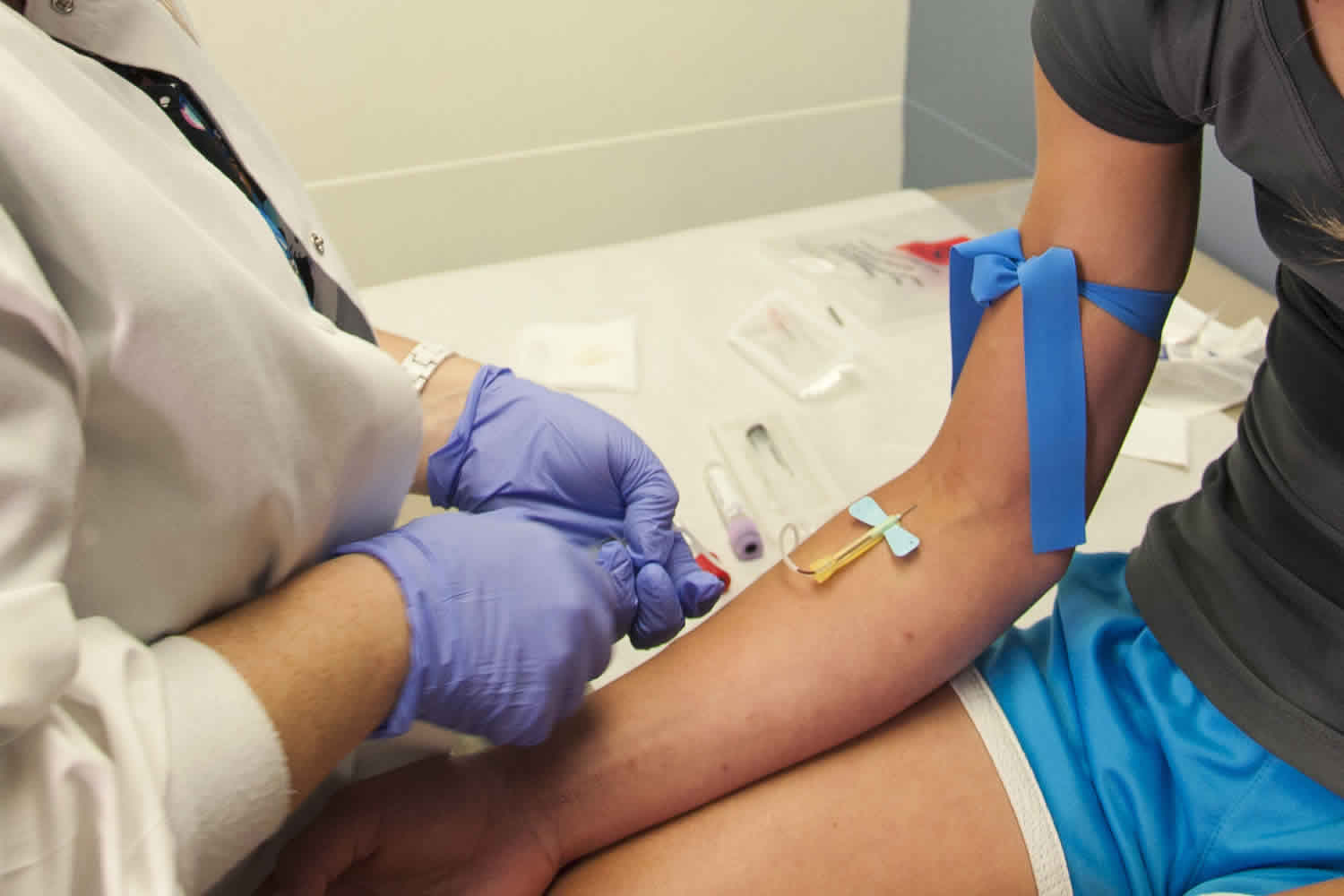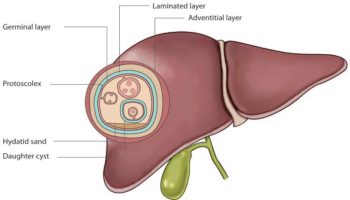Contents
What is CO2 blood test
CO2 blood test is also called bicarbonate blood test, measures the total amount of carbon dioxide (CO2) in your blood, which occurs mostly in the form of bicarbonate (HCO3-). The CO2 is mainly a by-product of various metabolic processes. Carbon dioxide (CO2) is an odorless, colorless gas. CO2 is a waste product made by your body. Your blood carries carbon dioxide to your lungs. You breathe out carbon dioxide and breathe in oxygen all day, every day, without thinking about it. A CO2 blood test measures the amount of carbon dioxide in your blood. Changes in your CO2 level may suggest that you are losing or retaining fluid. Too much or too little carbon dioxide in the blood can indicate a health problem. CO2 levels in the blood are affected by kidney and lung function. The kidneys help maintain the normal bicarbonate levels.
Bicarbonate is an electrolyte, a negatively charged ion that is used by the body to help maintain the body’s acid-base (pH) balance. It also works with the other electrolytes (sodium, potassium, and chloride) to maintain electrical neutrality at the cellular level.
Measuring bicarbonate as part of an electrolyte or metabolic panel may help diagnose an electrolyte imbalance or acidosis or alkalosis. Acidosis and alkalosis describe the abnormal conditions that result from an imbalance in the pH of the blood caused by an excess of acid or alkali (base). This imbalance is typically caused by some underlying condition or disease.
Your lungs and kidneys are the major organs involved in regulating blood pH through the removal of excess bicarbonate.
- Your lungs flush acid out of the body by exhaling CO2. Raising and lowering the respiratory rate alters the amount of CO2 that is breathed out, and this can affect blood pH within minutes.
- Your kidneys eliminate acids in the urine and they regulate the concentration of bicarbonate (HCO3-, a base) in blood. Acid-base changes due to increases or decreases in bicarbonate (HCO3-) concentration occur more slowly than changes in CO2, taking hours or days.
Any disease or condition that affects the lungs, kidneys, metabolism, or breathing has the potential to cause acidosis or alkalosis.
The bicarbonate test gives a healthcare practitioner a rough estimate of a patient’s acid-base balance. This is usually sufficient, but measurements of gases dissolved in the blood (blood gases) may be done if more information is needed. Bicarbonate is typically measured along with sodium, potassium, and possibly chloride in an electrolyte panel as it is the balance of these molecules that gives the healthcare practitioner the most information.
The CO2 test is most often done as part of an electrolyte or basic metabolic panel. Electrolytes help balance the levels of acids and bases in your body. Most of the carbon dioxide in your body is in the form of bicarbonate, which is a type of electrolyte. An electrolyte panel may part of a regular exam. The test may also help monitor or diagnose conditions related to an electrolyte imbalance. These include kidney diseases, lung diseases, and high blood pressure (hypertension).
An electrolyte panel may be used to help monitor conditions, such as kidney disease, lung disorders, and high blood pressure. When acidosis or alkalosis is identified, bicarbonate (as part of the electrolyte panel) and blood gases may be ordered to evaluate the severity of the pH imbalance. These tests help determine whether it is primarily respiratory (due to an imbalance between the amount of oxygen coming in and CO2 being released) or metabolic (due to increased or decreased amounts of bicarbonate in the blood). They also help monitor treatment until acid-base balance is restored.
However, if your test results are not in the normal range, it doesn’t necessarily mean you have a medical condition requiring treatment. Other factors, including certain medicines, can affect the level of CO2 in your blood. To learn what your results mean, talk to your health care provider.
How is carbon dioxide transported in the blood?
Most of the carbon dioxide in your body is in the form of bicarbonate, which is a type of electrolyte.
The pH of the human body ranges between 7.35 to 7.45, with the average at 7.40 1. The primary pH buffer system in the human body is the bicarbonate (HCO3-)/carbon dioxide (CO2) chemical equilibrium system 2. Where:
H + HCO3- <–> H2CO3 <–> CO2 + H2O
Bicarbonate (HCO3-) functions as an alkalotic substance. CO2 functions as an acidic substance. Therefore, increases in bicarbonate (HCO3-) or decreases in CO2 will make blood more alkalotic. The opposite is also true where decreases in HCO3 or an increase in CO2 will make blood more acidic. CO2 levels are physiologically regulated by the pulmonary system through respiration, whereas the HCO3 levels are regulated through the renal system with reabsorption rates. Therefore, metabolic alkalosis is an increase in serum HCO3.
When is CO2 blood test ordered?
Bicarbonate testing (CO2 blood test) may be ordered, usually as part of an electrolyte panel, a basic metabolic panel (BMP), or a comprehensive metabolic panel (CMP), when a person has a routine health checkup.
This testing may be ordered when acidosis or alkalosis is suspected or when someone has an acute condition with symptoms that may include the following:
- Prolonged vomiting and/or diarrhea
- Weakness, fatigue
- Difficulty breathing (respiratory distress)
Electrolytes may be ordered at regular intervals when a person has a disease or condition or is taking a medication that can cause an electrolyte imbalance. Electrolyte panels or basic metabolic panels are commonly used to monitor treatment of certain problems, including high blood pressure (hypertension), heart failure, and liver and kidney disease.
Why do I need a CO2 in blood test?
Your health care provider may have ordered a CO2 blood test as part of your regular checkup or if you have symptoms of an electrolyte imbalance. These include:
- Difficulty breathing
- Weakness
- Fatigue
- Prolonged vomiting and/or diarrhea
If I’ve had a total CO2 test, why does my doctor want to test my blood gases?
Blood gas tests (arterial blood gas), in which blood is drawn from an artery instead of a vein, can give your healthcare practitioner more information about your acid-base balance. They can tell your provider whether your lungs are working properly to keep oxygen and carbon dioxide at healthy levels.
How the CO2 blood test is performed
A blood sample is needed. Most of the time blood is drawn from a vein located on the inside of the elbow or the back of your hand. A health care professional will take a blood sample from a vein in your arm, using a small needle.
How to prepare for the CO2 blood test
Many medicines can interfere with blood test results.
- Your health care provider will tell you if you need to stop taking any medicines before you have this test.
- DO NOT stop or change your medicines without talking to your provider first.
- Drugs that may decrease bicarbonate levels include methicillin, nitrofurantoin, tetracycline, thiazide diuretics, and triamterene.
- Some drugs may increase bicarbonate levels including fludrocortisone, barbiturates, bicarbonates, hydrocortisone, loop diuretics, and steroids.
Carbon dioxide levels in blood
The normal CO2 level is 23 to 29 milliequivalents per liter (mEq/L) or 23 to 29 millimoles per liter (mmol/L).
Normal carbon dioxide value ranges may vary slightly among different laboratories. Talk to your doctor about the meaning of your specific test results.
The example above shows the common measurement range of results for these tests. Some laboratories use different measurements or may test different specimens.
What does abnormal CO2 results mean
Abnormal carbon dioxide levels may indicate that your body has an electrolyte imbalance, or that there is a problem removing carbon dioxide through your lungs. Abnormal carbon dioxide levels suggests that your body is having trouble maintaining its acid-base balance, either by failing to remove carbon dioxide through the lungs or the kidneys or perhaps because of an electrolyte imbalance, particularly a deficiency of potassium. Both of these imbalances may be due to a wide range of conditions.
Too much CO2 in the blood can indicate a variety of conditions including:
High carbon dioxide levels in blood
- Breathing disorders
- Cushing syndrome
- Hyperaldosteronism, e.g., primary aldosteronism (Conn syndrome)
- Vomiting
- Lung diseases, e.g., chronic obstructive pulmonary disease (COPD)
- Disorders of the adrenal glands. Adrenal glands are located above the kidneys and help control heart rate, blood pressure, and other bodily functions.
- Hormonal disorders
- Kidney disorders
- Alkalosis, a condition in which you have too much base in your blood
Low carbon dioxide levels in blood
- Addison disease, a condition in which your body’s adrenal glands don’t produce enough of certain types of hormones. The condition can cause a variety of symptoms including weakness, dizziness, weight loss, and dehydration.
- Diarrhea
- Ethylene glycol poisoning
- Acidosis, a condition in which you have too much acid in your blood
- Ketoacidosis, a complication of type 1 and type 2 diabetes
- Kidney disease
- Lactic acidosis
- Metabolic acidosis
- Methanol poisoning
- Respiratory alkalosis, which can be caused by hyperventilation
- Salicylate toxicity (such as aspirin overdose)
- Shock
Other conditions may also alter bicarbonate levels
- Alkalosis
- Delirium
- Dementia
- Renal tubular acidosis; distal
- Renal tubular acidosis; proximal
If CO2 levels are too high or low, what treatments can help?
If your carbon dioxide in blood is high or low, your healthcare practitioner will identify and treat the underlying cause. For example, high bicarbonate may be caused by emphysema, which may be treated with oxygen therapy and medications, or by severe diarrhea or vomiting, which would be addressed by treating the cause of the diarrhea or vomiting. Low bicarbonate may be caused by diabetic ketoacidosis, for example, which can be addressed in part by fluid and electrolyte replacement and insulin therapy.
- Hopkins E, Sharma S. Physiology, Acid Base Balance. [Updated 2018 Oct 27]. In: StatPearls [Internet]. Treasure Island (FL): StatPearls Publishing; 2018 Jan-. Available from: https://www.ncbi.nlm.nih.gov/books/NBK507807[↩]
- Brinkman JE, Sharma S. Physiology, Alkalosis, Metabolic. [Updated 2018 Oct 27]. In: StatPearls [Internet]. Treasure Island (FL): StatPearls Publishing; 2018 Jan-. Available from: https://www.ncbi.nlm.nih.gov/books/NBK482291[↩]





